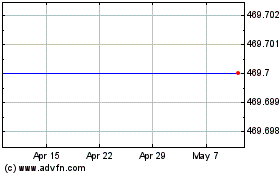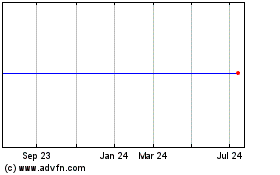By Timothy Puko
The U.S. oil price tumbled to a fresh six-year low on Wednesday
on the latest sign of a glut in crude supplies.
The amount of crude held in the nation's commercial stockpiles
unexpectedly rose last week, according to data released on
Wednesday by the U.S. Energy Information Administration.
Brokers and analysts attributed the surprise increase to a rise
in imports. That underscores belief that the world's largest crude
exporter, Saudi Arabia, and the Organization of the Petroleum
Exporting Countries will continue pumping even as prices
decline.
The benchmark crude-oil price in the U.S. slid 4.3% to $40.80 a
barrel, the lowest settlement on the New York Mercantile Exchange
since March 2009. Brent, the global benchmark, lost $1.65, or 3.4%,
to $47.16 a barrel on ICE Futures Europe, the lowest settlement
since Jan. 13.
"Clearly OPEC has produced a lot more than what people expected
they would," said David Meaney, portfolio manager at BP Capital LP.
"U.S. producers have been amazing in their resilience."
The decline spread across markets, helping to pull down the Dow
149 points, or 0.9%, to 17362. U.S. oil-and-gas producers filled
the list of the worst performers with Marathon Oil Corp. atop the
list, down 5.2%. Currencies in major oil-producing countries like
Russia and Norway continued their grind down compared with the
dollar this week, with the Mexican peso on pace Wednesday to close
at another all-time low.
Rising production in the U.S. and Saudi Arabia has overwhelmed
the world market for oil, pushing prices down 55% from year-ago
levels. That has crunched budgets in oil-producing nations and
states, and been a win for U.S. drivers who have been paying less
at the pump for gasoline.
In the weekly EIA report, average daily U.S. output fell in the
week ended Aug. 14, but by only 0.5%. At 9.3 million barrels a day,
U.S. output is still on track to be the highest since 1972. The
decline was more than covered by the growth in imports, up 6.1% for
the week to 7.6 million barrels a day, about the same as a year ago
despite the fall in prices, the EIA said.
"While a renewed decline in (U.S.) drilling activity might
provide some support for prices, at best they are only likely to
grind a little higher over the next few years," analysts at Capital
Economics said in a note to clients.
Wednesday's fall in futures was the biggest one-day percentage
slide in a month; and most of it came in just 15 minutes after the
EIA report, which showed crude-oil inventories grew by 2.6 million
barrels last week. Analysts had predicted a 1.1 million-barrel
fall.
That "got everybody by surprise," said Scott Shelton, broker at
ICAP PLC. "I don't see anything good in this report."
Other recent data from the EIA and also the International Energy
Agency suggest oversupply is somewhere between 500,000 and three
million barrels a day world-wide and could linger for longer than
what was once commonly expected. Many had thought the plunge in oil
prices would force producers to spend less and cut back, but,
instead, producers have found it would be more costly to slow
output than it is to pump more oil from fewer, but more-efficient
wells.
As more data comes out, it reinforces fears that the standoff
won't end and prices won't recover any time soon, said Dean
Hazelcorn, trader at the brokerage Coquest Inc. in Dallas.
Citigroup Inc. issued a note Wednesday saying it is conceivable
U.S. prices could revisit the 2008 low of $32.40 and that the fall
is likely to keep going until U.S. shale producers get cut off from
the loans and investor money that keeps them pumping.
"The market's been given zero reason to buy," Mr. Hazelcorn
said.
Domestic crude inventories grew to 456.2 million barrels last
week, up from 453.6 million last week, the EIA said. The EIA's
weekly production figures are based on a statistical model, not
reported production.
Gasoline stockpiles fell by 2.7 million barrels. Analysts had
expected gasoline supplies fall by 1.4 million barrels.
Gasoline futures settled down 8.76 cents, or 5.3%, at $1.5592 a
gallon.
Diesel supplies rose by 594,000 barrels, less than the
1.2-million-barrel increase that analysts had expected.
Diesel futures lost 4.06 cents, or 2.6%, to $1.518 a gallon
Georgi Kantchev
contributed to this article.
Write to Timothy Puko at tim.puko@wsj.com
Subscribe to WSJ: http://online.wsj.com?mod=djnwires
(END) Dow Jones Newswires
August 19, 2015 15:28 ET (19:28 GMT)
Copyright (c) 2015 Dow Jones & Company, Inc.
ICAP (LSE:IAP)
Historical Stock Chart
From Mar 2024 to Apr 2024

ICAP (LSE:IAP)
Historical Stock Chart
From Apr 2023 to Apr 2024
